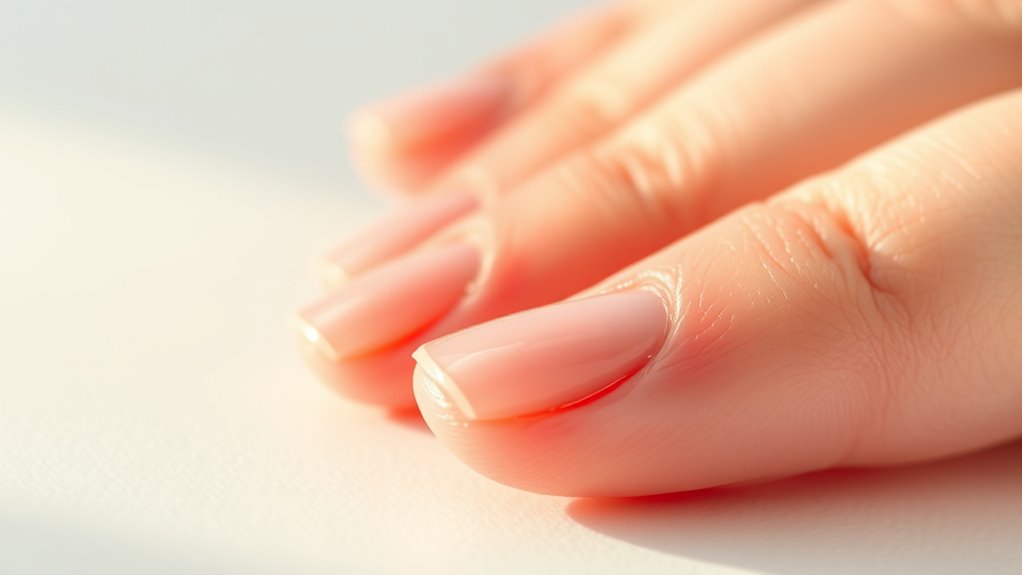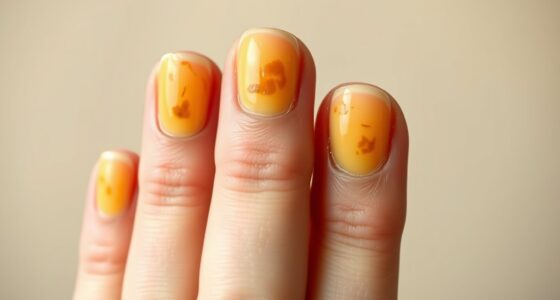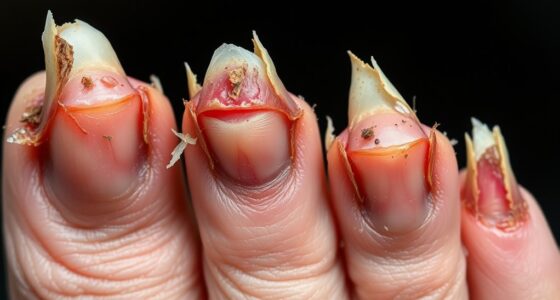Your nails can reveal a lot about your health, from nutritional deficiencies like iron or vitamin shortages to signs of systemic issues such as thyroid problems or skin conditions like psoriasis. Changes in color, texture, or shape might point to underlying health concerns or infections. Pay attention to unusual spots, ridges, or brittleness, as these can be early clues. If you’re curious about what your nails might be telling you, there’s more to uncover about your overall wellness.
Key Takeaways
- Changes in nail color, such as yellow or pale, can indicate infections, anemia, or liver issues.
- Nail ridges, pitting, or irregular shapes may signal skin conditions like psoriasis or systemic health problems.
- Brittle, thin, or weak nails often reflect nutritional deficiencies in calcium, magnesium, or biotin.
- Spoon-shaped or deformed nails can be signs of iron deficiency, thyroid issues, or other internal health concerns.
- Persistent abnormalities or pain in nails should prompt medical evaluation for underlying health conditions.
Recognizing the Signs of Nutritional Deficiencies
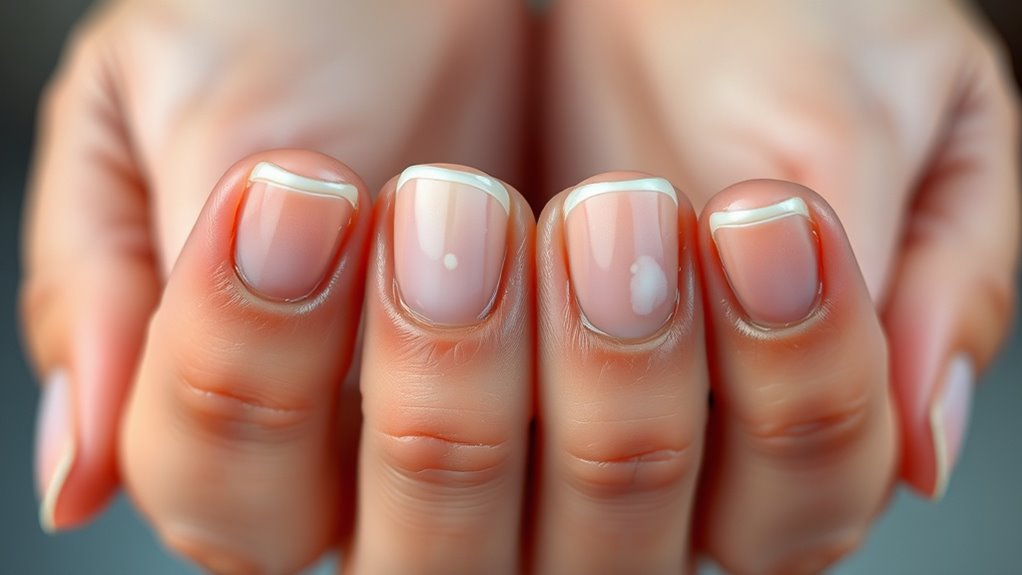
Your nails can reveal important clues about your overall health, especially when it comes to nutritional deficiencies. If you notice pale or brittle nails, it might indicate vitamin deficiencies like biotin or iron deficiency anemia. White spots or lines could signal zinc deficiency, while ridges running vertically may point to a lack of essential minerals. Weak, thin nails often suggest inadequate calcium or magnesium intake. Pay attention to changes in nail color or texture, as these can serve as early signs of deficiencies that affect your body’s functioning. Recognizing these signs allows you to address potential nutritional gaps early. Improving your diet with nutrient-rich foods can help restore nail health and prevent further deficiencies. Nail health can also be influenced by overall hydration and lifestyle choices, emphasizing the importance of a holistic approach. Additionally, AI-driven diagnostics are emerging as innovative tools to detect health issues related to nutritional deficiencies more accurately. Being mindful of sleep patterns can also support overall wellness, as poor sleep can impact nutrient absorption and health. Incorporating mindful lifestyle habits can further enhance your overall well-being and support proper nutrient utilization. Always consult a healthcare professional for proper diagnosis and guidance.
Indicators of Skin and Systemic Diseases
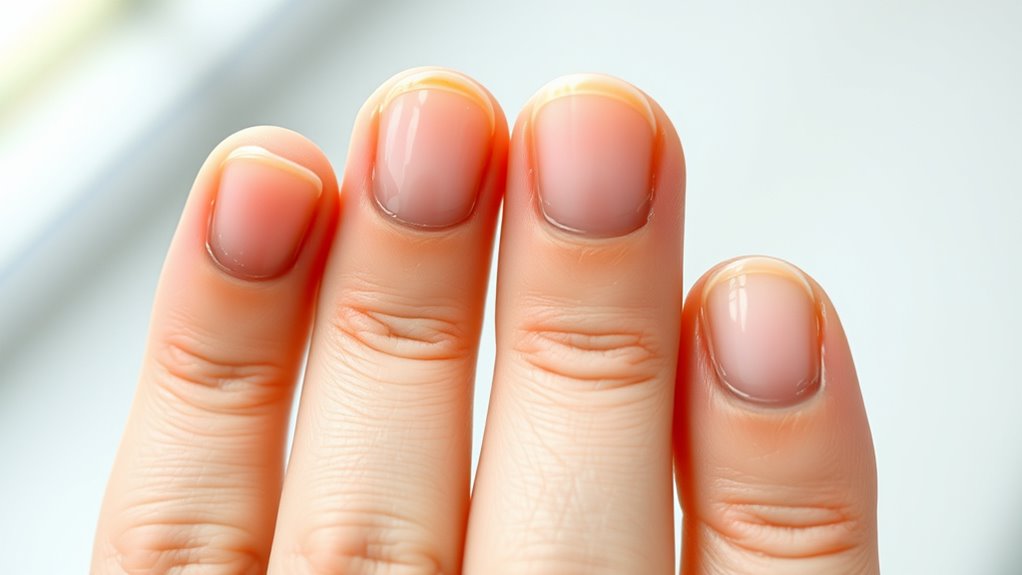
Changes in the appearance of your nails can signal more than just nutritional issues; they often reflect underlying skin or systemic conditions. You might notice ridges, discoloration, or unusual shapes that could hint at health concerns. For example:
- Pitting or small dents may indicate psoriasis or eczema.
- Yellowing nails can be a sign of respiratory issues or fungal infections.
- Spoon-shaped nails might point to iron deficiency or thyroid problems.
- Certain nail modifications and health indicators are also influenced by overall systemic health, including conditions like hormonal imbalances.
Additionally, the health of your nails can be affected by hydrotherapy practices such as soaking or treatments that improve circulation and skin health. Proper nail care routines can also help maintain nail integrity and prevent issues linked to nutritional deficiencies. Regularly assessing nail health can provide early clues to chronic health issues, encouraging timely medical consultation. Pay attention to these signs, and consider adjusting your nail care routines or exploring current nail art trends that emphasize healthy nails. Recognizing these indicators early can lead to prompt medical attention and better overall health. Your nails are more than just a canvas for beauty—they’re a window into your systemic well-being.
Understanding Nail Color Changes
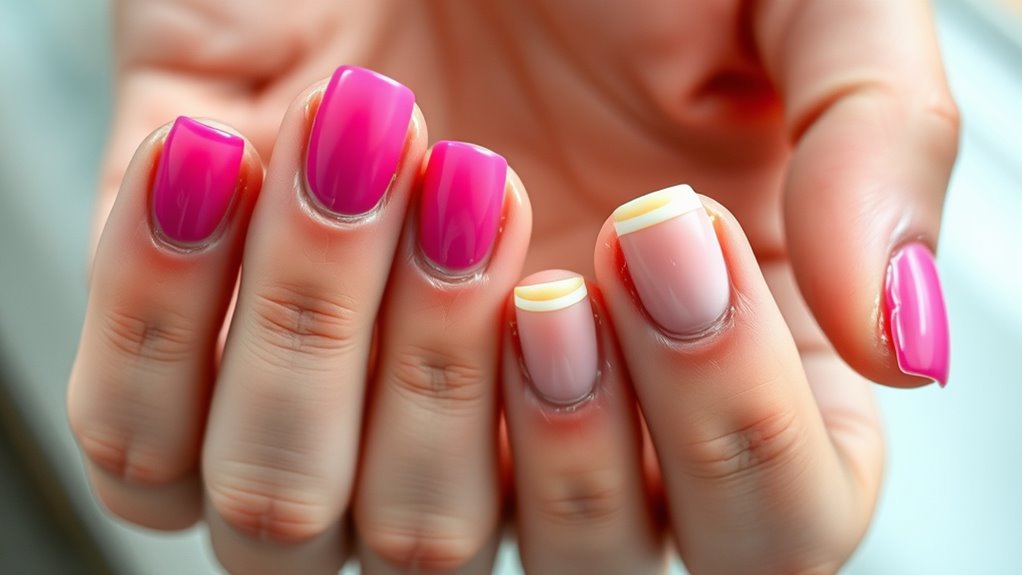
Have you ever noticed your nails’ color shifting unexpectedly? Changes can be caused by factors like poor nail hygiene or cosmetic treatments. For example, yellow nails might result from smoking or fungal infections, while pale nails could indicate anemia or liver issues. Dark streaks or spots may be linked to trauma or melanoma, so it’s important to monitor any new or unusual discoloration. Regular nail hygiene helps prevent infections that could alter nail color. If you notice persistent or sudden changes, it’s wise to consult a healthcare professional rather than relying solely on cosmetic treatments. While some color changes are harmless, others signal underlying health conditions. Understanding nail health can help you recognize when to seek medical advice and maintain healthy nails. Additionally, changes in nail color can sometimes reflect broader aura or emotional states, providing insights into your overall wellness. Maintaining proper nail hygiene is essential for overall health and early detection of potential issues.
The Significance of Nail Texture and Shape
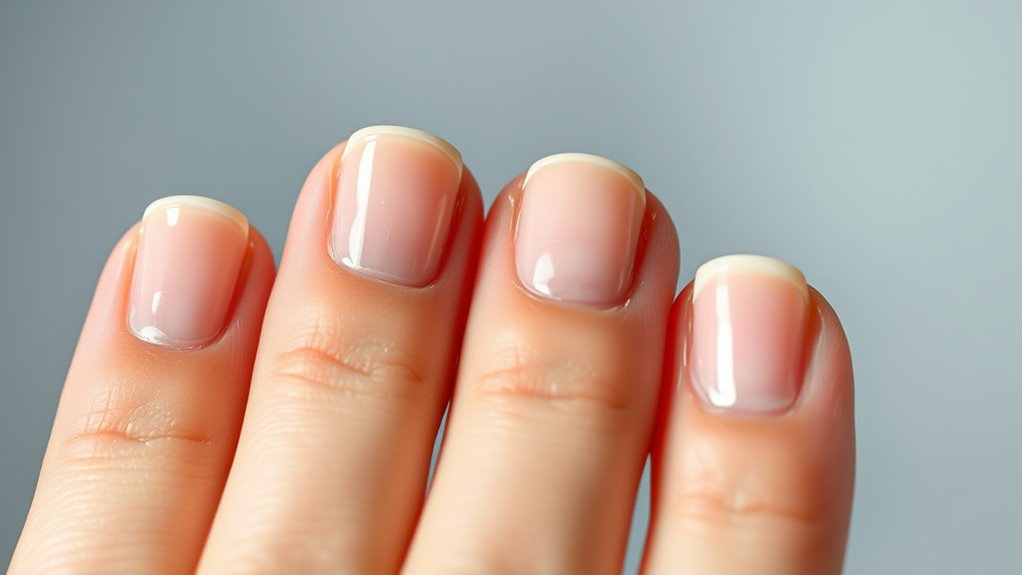
Nail texture and shape can reveal important clues about your overall health. When you pay attention to your nails, you notice more than just their appearance; they reflect your body’s internal state. Smooth, evenly shaped nails indicate good health, while ridges, pitting, or irregular shapes may signal underlying issues. Proper nail grooming enhances nail aesthetics, making it easier to spot changes early. Imagine nails with:
Healthy nails reflect your internal well-being; watch for ridges, pitting, or irregularities as signs of potential issues.
- Deep grooves or ridges running vertically
- Brittle, peeling edges
- Unusual curves or spoon-shaped nails
These signs can suggest nutritional deficiencies, skin conditions, or systemic health concerns. Recognizing these cues encourages timely action and promotes overall wellness. Your nails are more than cosmetic; they’re a window into your health, making attentive nail care essential. For example, changes in nail texture can sometimes be associated with skincare innovations and formulations that support nail health. Additionally, understanding energy monitoring features like those in household appliances can help you maintain a healthy lifestyle by managing your household’s energy consumption, indirectly supporting your overall well-being.
When to Seek Medical Advice for Nail Concerns
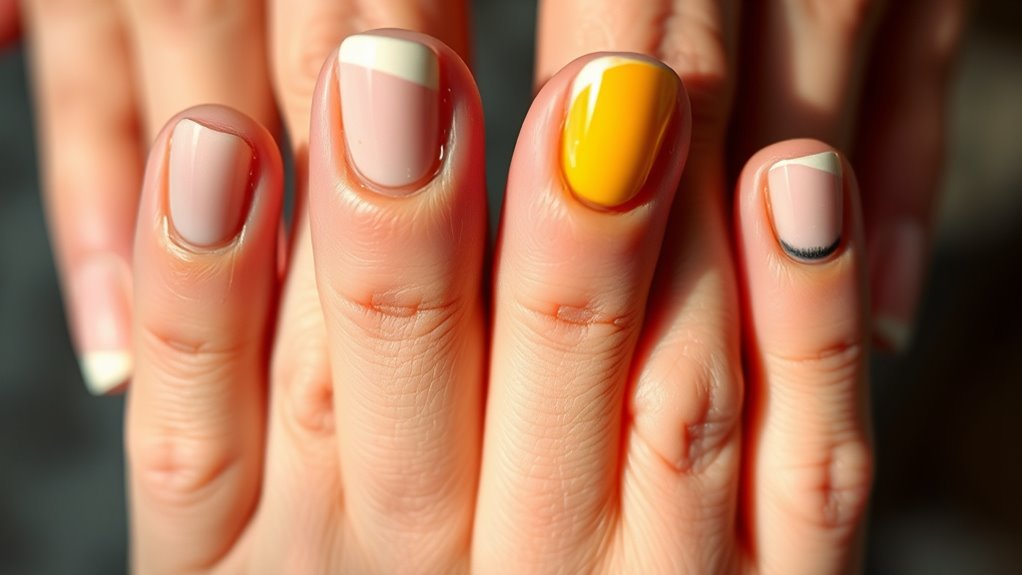
While minor variations in nail texture and shape can be normal, certain signs warrant professional evaluation. If you notice persistent changes like discoloration, thickening, or separation from the nail bed, it’s time to see a healthcare provider. These may indicate underlying health issues or infections that require medical treatment. Additionally, if nail hygiene has been properly maintained but issues persist, don’t overlook them—they could signal a medical condition. Understanding nail health can help you identify when to seek help early. Cosmetic concerns, such as uneven nails or persistent ridges, are common but should be evaluated if they worsen or don’t improve. Seek advice if you experience pain, bleeding, or nail deformities. Prompt attention ensures proper diagnosis and treatment, helping you address potential health problems early and maintain healthy nails. Proper nail care and avoiding harsh chemicals can also impact nail health. Recognizing signs of infection in the nails is important, as infections can sometimes require medical intervention to prevent further complications.
Frequently Asked Questions
Can Nail Conditions Be Hereditary?
Hereditary traits and genetic predispositions can influence your nail conditions. You might notice certain nail features running in your family, like ridges or brittleness. While some nail issues are inherited, others develop due to external factors or health problems. Understanding your family’s nail history helps determine if your condition is hereditary. If you’re concerned, consult a healthcare professional to explore whether genetics play a role in your nail health.
Do Nail Issues Indicate Mental Health Concerns?
Nail issues can sometimes reflect mental health concerns, especially if stress or anxiety affects your nail hygiene or leads to habits like nail-biting. While cosmetic treatments can improve nail appearance, frequent trauma from poor mental health might cause changes like ridges or discoloration. If you’re noticing persistent nail problems, it’s good to take mental health into account as a factor and consult a healthcare professional to address underlying concerns.
How Do Environmental Factors Affect Nail Health?
Environmental factors, like exposure to environmental toxins, can markedly impact your nail health. When you use nail polish frequently without a break, it can weaken your nails and cause brittleness. Toxins in the environment can also lead to discoloration or damage. Make sure you give your nails time to breathe and choose nail products free from harmful chemicals to keep your nails healthy and strong.
Can Nail Changes Predict Future Health Problems?
They say, “Forewarned is forearmed,” and your nails can indeed predict future health issues. Changes like nail pigmentation or shape alterations might signal underlying conditions such as deficiencies or illnesses. By paying attention to these signs, you can catch problems early. Your nails serve as a window into your health, so stay vigilant—early detection through noticing these changes can lead to timely medical advice and better outcomes.
Are There Natural Remedies for Common Nail Issues?
You can try herbal remedies like tea tree oil or coconut oil to treat common nail issues, such as fungal infections or dryness. Additionally, adjusting your diet by increasing intake of biotin-rich foods, like eggs and nuts, can strengthen your nails naturally. Remember, maintaining good hygiene and staying hydrated also help prevent problems. Combining these natural remedies and diet adjustments offers a gentle way to improve nail health without harsh chemicals.
Conclusion
Your nails can reveal more about your health than you might realize—sometimes even before symptoms appear. Did you know that nail abnormalities are linked to over 50 different medical conditions? By paying attention to changes in color, texture, or shape, you can catch potential issues early. Regularly inspecting your nails helps you stay proactive about your well-being. Remember, when in doubt, consult a healthcare professional to keep your health in check.
